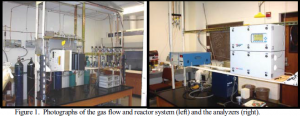Aaron Nackos and Dr. Calvin H. Bartholomew, Chemical Engineering
Nitric oxides (NO and NO2, or NOx for short) are significant contributors to photochemical smog and acid rain and are mainly produced from automobile emissions and from coal combustion used to generate electric power. Because of these issues, the EPA will require by the year 2004 that NOx emissions from coal-fired plants in this country meet strict pollution limitations—up to a 90% reduction in the amount of NOx currently allowed to be released by the EPA (Belden 41).
The Chemical Engineering Department at Brigham Young University is working on understanding and modeling the performance of vanadium-based catalysts, which are currently the most promising NOx abatement technology. This concept behind this technology is simple: ammonia gas (the reducing agent) is injected into the flue gas from a coal boiler and the mixture is run over a ceramic monolith or plates, which are coated with the active catalyst material (vanadia, or V2O5). The catalyst is selective for the following two reactions to inert byproducts:
![]()
Over time, SCR catalysts lose effectiveness because they become deactivated, either by deposition of material that blocks the catalyst surface, or by chemical poisoning, the strong adsorption of reactants, products, or impurities on sites otherwise available for catalysis (Farrauto and Bartholomew 266).
My research involves the simulation of typical conditions found in a commercial power plant and the comparison of the activity of several catalyst samples that have been poisoned to various degrees by potassium, sodium, and calcium. The work done over the past year has involved the construction of a very unique reactor system, which is displayed in Figure 1. The system allows four samples of powdered catalyst to be analyzed at a time. The samples are placed inside a tube inserted into a furnace. A gas mixture representative of typical coal-fired power plants (0.1% SO2, 0.1% NH3, 0.1% NO, 2% O2, 10% H2O, and the balance inert He) is flowed over the catalyst, and analytical instruments measure how much NO is converted to N2.
Designing and building this system was a challenge as our group had to develop its expertise and stay within budget. Some of the interesting and key features are described here:
- Safety was of utmost concern, and much effort went into ensuring that human exposure to toxic gases does not occur. Specially designed manifolds were installed in order to vent gas to a fume hood in the case of pressure regulator failure. Special electronic gas sensors and alarms are scheduled to be installed as well.
- Maintaining an exact mixture and exact flowrate of gases was a challenge. 14 mass flow controllers were installed in a series-parallel configuration so that the correct mixture of gases could be made and split into four equal streams.
- Water vapor is introduced into the system by bubbling the reactor feed gas through a heated chamber containing distilled water. The amount of water vapor introduced is a function of the temperature of the bubbler, which is carefully controlled.
- The system is being configured so that it may be automated. Gas flow rates, valve switching, data acquisition, and other features are controlled and monitored by a computer. As a typical run on each catalyst may take days at a time to perform and includes steady-state as well as transient tests, this automatic control will save time and should reduce experimental inconsistency due to operator errors.
Although much has been accomplished in the design and construction of this system, actual tests on catalyst samples have not yet been performed. As these issues are resolved, progress is being made in the experimental design.
Currently, the statistical design of the experiments is being finalized, with plans to use four levels of poisoning each of calcium, potassium, sodium, and possibly arsenic. Two reaction temperatures will be investigated. Experiments simulating the effects of foulants such as calcium sulfate that can plug or block the active catalyst surface are also being considered.
We expect that the results will allow us to create a model of how long an SCR catalyst can endure the harsh conditions present in the flue gas of a coal-fired boiler before it needs replacement, based on the type of coal burned. We may also investigate ways in which to regenerate deactivated catalysts, potentially avoiding high replacement costs, or at least postponing them.
References
- Belden, Roy S. The Clean Air Act. Chicago: Section of Environment, Energy, and Resources, American Bar Association, 2001.
- Farrauto, Robert J. and Calvin H. Bartholomew. Fundamentals of Industrial Catalytic Processes. Blackie Academic & Professional: New York, 1997.

